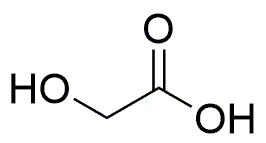Glycolic acid is widely utilized in research focused on:
- Cosmetic Industry: Commonly found in skincare products, glycolic acid is known for its exfoliating properties, helping to remove dead skin cells and improve skin texture. This makes it a popular choice for anti-aging creams and chemical peels.
- Pharmaceuticals: It serves as a key ingredient in various topical formulations, enhancing the absorption of other active ingredients. This property is particularly beneficial in delivering medications effectively through the skin.
- Textile Industry: Glycolic acid is used in the dyeing and finishing processes of textiles, improving the quality and durability of fabrics. Its ability to modify the surface of fibers enhances color retention and fabric feel.
- Food Industry: As a food additive, it acts as a pH regulator and preservative. This helps in maintaining the freshness and safety of food products, making it valuable in food processing.
- Research Applications: In laboratories, glycolic acid is often used in biochemical assays and as a reagent in organic synthesis, aiding researchers in various chemical reactions and studies.
General Information
Properties
Safety and Regulations
Applications
Glycolic acid is widely utilized in research focused on:
- Cosmetic Industry: Commonly found in skincare products, glycolic acid is known for its exfoliating properties, helping to remove dead skin cells and improve skin texture. This makes it a popular choice for anti-aging creams and chemical peels.
- Pharmaceuticals: It serves as a key ingredient in various topical formulations, enhancing the absorption of other active ingredients. This property is particularly beneficial in delivering medications effectively through the skin.
- Textile Industry: Glycolic acid is used in the dyeing and finishing processes of textiles, improving the quality and durability of fabrics. Its ability to modify the surface of fibers enhances color retention and fabric feel.
- Food Industry: As a food additive, it acts as a pH regulator and preservative. This helps in maintaining the freshness and safety of food products, making it valuable in food processing.
- Research Applications: In laboratories, glycolic acid is often used in biochemical assays and as a reagent in organic synthesis, aiding researchers in various chemical reactions and studies.
Documents
Safety Data Sheets (SDS)
The SDS provides comprehensive safety information on handling, storage, and disposal of the product.
Product Specification (PS)
The PS provides a comprehensive breakdown of the product’s properties, including chemical composition, physical state, purity, and storage requirements. It also details acceptable quality ranges and the product's intended applications.
Certificates of Analysis (COA)
Search for Certificates of Analysis (COA) by entering the products Lot Number. Lot and Batch Numbers can be found on a product’s label following the words ‘Lot’ or ‘Batch’.
*Catalog Number
*Lot Number
Certificates Of Origin (COO)
This COO confirms the country where the product was manufactured, and also details the materials and components used in it and whether it is derived from natural, synthetic, or other specific sources. This certificate may be required for customs, trade, and regulatory compliance.
*Catalog Number
*Lot Number
Safety Data Sheets (SDS)
The SDS provides comprehensive safety information on handling, storage, and disposal of the product.
DownloadProduct Specification (PS)
The PS provides a comprehensive breakdown of the product’s properties, including chemical composition, physical state, purity, and storage requirements. It also details acceptable quality ranges and the product's intended applications.
DownloadCertificates of Analysis (COA)
Search for Certificates of Analysis (COA) by entering the products Lot Number. Lot and Batch Numbers can be found on a product’s label following the words ‘Lot’ or ‘Batch’.
*Catalog Number
*Lot Number
Certificates Of Origin (COO)
This COO confirms the country where the product was manufactured, and also details the materials and components used in it and whether it is derived from natural, synthetic, or other specific sources. This certificate may be required for customs, trade, and regulatory compliance.


